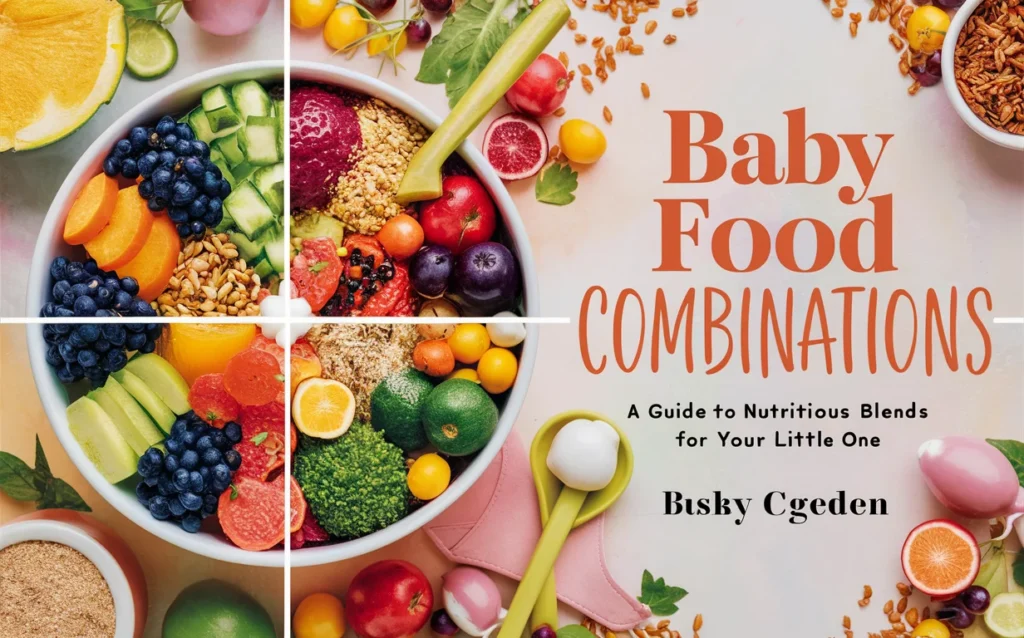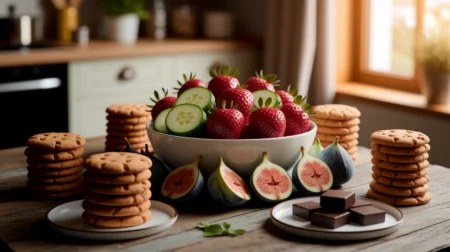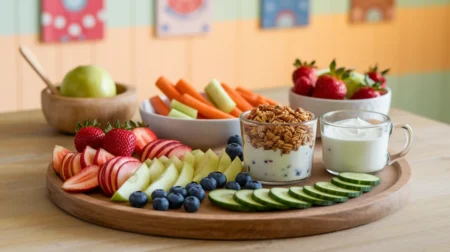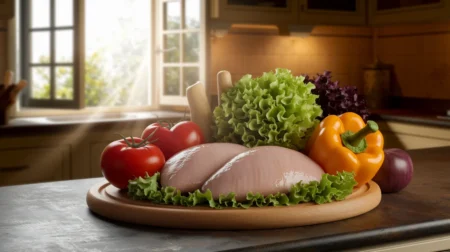Baby Food Combinations
Key Takeaways:
- Homemade baby food combinations offer a nutritious way to introduce a variety of flavors and textures to your child.
- Mixing different fruits, vegetables, grains, and proteins ensures a well-rounded diet rich in vitamins, minerals, and fiber.
- Baby food blends can easily be adjusted to suit your baby’s stage of eating development.
When your baby is ready to start exploring solid foods, offering a variety of homemade baby food combinations can help them develop a taste for nutritious meals early on. Not only do these combinations provide essential nutrients for growth and development, but they also allow parents to introduce diverse flavors and textures in a healthy and controlled way. Let’s explore some delicious and easy-to-make baby food blends and toddler puree recipes that will benefit your little one’s palate and nutritional needs.

1. Avocado and Banana Mash
Avocado is packed with healthy fats that support brain development, while banana offers potassium and natural sweetness that babies love.
Ingredients:
- 1 ripe avocado
- 1 ripe banana
Preparation:
- Scoop out the avocado flesh into a bowl.
- Add the banana and mash both together with a fork until smooth.
- Serve immediately to avoid browning, or store in the refrigerator for up to 1 day.
Nutritional Benefits:
- Healthy Fats: Avocado provides essential fats for brain health.
- Potassium: Banana helps regulate fluid balance and supports muscle function.
2. Sweet Potato and Carrot Puree
This vibrant orange blend is rich in beta-carotene, which is essential for healthy eyesight and immune function. Both vegetables are naturally sweet, making this a favorite for babies.
Ingredients:
- 1 medium sweet potato
- 2 large carrots
Preparation:
- Peel and chop the sweet potato and carrots into small pieces.
- Steam or boil the vegetables for 15-20 minutes until tender.
- Blend or mash until smooth, adding water or breast milk to reach the desired consistency.
Nutritional Benefits:
- Beta-Carotene: Both sweet potatoes and carrots are high in this antioxidant, promoting healthy vision.
- Fiber: Supports digestion and prevents constipation.
3. Apple and Oatmeal Puree
This is a classic combination of fruit and grain that makes for a filling, nutritious meal. Apples provide vitamins, while oats offer fiber and slow-release energy.
Ingredients:
- 1 apple (peeled, cored, and chopped)
- 1/4 cup rolled oats
- 1/2 cup water or breast milk
Preparation:
- Cook the oats in water or breast milk until soft, about 5 minutes.
- Steam or boil the apple pieces until soft.
- Blend the apple and oatmeal together to create a smooth puree, adding extra liquid if needed.
Nutritional Benefits:
- Vitamins C and A: Apples provide essential vitamins for growth and immunity.
- Whole Grains: Oats offer fiber and sustained energy for growing babies.
4. Spinach, Pear, and Pea Blend
This green puree is a nutritional powerhouse. Spinach is rich in iron, while peas provide protein, and pears add sweetness and vitamins.
Ingredients:
- 1/2 cup fresh spinach leaves
- 1/2 cup peas (fresh or frozen)
- 1 ripe pear (peeled, cored, and chopped)
Preparation:
- Steam the peas and spinach until tender.
- Steam or boil the pear pieces separately.
- Blend all ingredients together until smooth, adding water or breast milk if necessary.
Nutritional Benefits:
- Iron: Spinach is high in iron, important for red blood cell production.
- Vitamin C: Pears offer vitamin C, which aids in iron absorption and boosts immunity.
5. Blueberry, Apple, and Quinoa Mash
Quinoa adds a protein boost to this fruity blend, making it a great option for babies transitioning to more textured foods. Blueberries are packed with antioxidants, and apples provide fiber.
Ingredients:
- 1/2 cup cooked quinoa
- 1/2 cup blueberries (fresh or frozen)
- 1 apple (peeled, cored, and chopped)
Preparation:
- Cook the quinoa according to package instructions and set aside.
- Steam or boil the apple pieces and blueberries until soft.
- Blend all ingredients together until smooth, adding water or breast milk as needed.
Nutritional Benefits:
- Complete Protein: Quinoa contains all nine essential amino acids.
- Antioxidants: Blueberries are rich in antioxidants that support brain and eye health.
6. Chicken and Butternut Squash Puree
This savory combination introduces protein through chicken, paired with the natural sweetness of butternut squash. It’s a great option for babies who are ready for more complex flavors.
Ingredients:
- 1 small chicken breast (cooked and diced)
- 1/2 cup butternut squash (peeled and chopped)
Preparation:
- Steam or boil the butternut squash until tender.
- Blend the chicken and squash together, adding water or broth to reach the desired consistency.
Nutritional Benefits:
- Protein: Chicken provides the building blocks for muscle and tissue development.
- Vitamins A and C: Butternut squash is rich in these important vitamins.
7. Pear and Zucchini Mash
This simple combination introduces your baby to the mild flavor of zucchini paired with the sweetness of pear. It’s easy on the digestive system and packed with essential vitamins.
Ingredients:
- 1 medium zucchini (chopped)
- 1 pear (peeled, cored, and chopped)
Preparation:
- Steam the zucchini and pear together for about 10-15 minutes until soft.
- Mash or blend until smooth.
Nutritional Benefits:
- Vitamin A: Zucchini provides vitamin A, crucial for vision and growth.
- Fiber: Pears offer fiber for digestive health.
8. Lentil and Vegetable Stew
This hearty stew introduces your baby to plant-based proteins and fiber. Lentils are an excellent source of iron and protein, paired with nutrient-rich vegetables like carrots and potatoes.
Ingredients:
- 1/4 cup red lentils
- 1 small carrot (peeled and chopped)
- 1 small potato (peeled and chopped)
- 1 cup water or low-sodium broth
Preparation:
- Rinse the lentils thoroughly.
- Combine lentils, carrots, potatoes, and water in a pot. Bring to a boil, then simmer for 20 minutes until everything is soft.
- Blend or mash the stew to the desired texture for your baby.
Nutritional Benefits:
- Iron: Lentils are an excellent source of plant-based iron.
- Protein: Supports muscle growth and development.
Conclusion
Creating your own baby food combinations gives you control over the ingredients, ensuring your little one receives nutritious, flavorful meals. These baby food blends are easy to prepare, full of vitamins, and introduce a range of textures and flavors that are crucial for developing healthy eating habits. By incorporating a mix of fruits, vegetables, grains, and proteins, you’re setting the foundation for a well-rounded diet that will nourish your baby’s growth.
FAQ
1. Can I freeze these baby food combinations?
Yes, most of these combinations can be frozen for up to 3 months. Use ice cube trays for portioning, and defrost as needed.
2. How do I introduce new flavors to my baby?
Start with single-ingredient purees and gradually introduce new flavors by combining foods they are already familiar with.
3. Can I add spices to baby food blends?
Yes, mild spices like cinnamon, turmeric, or cumin can be introduced once your baby is used to solids, but avoid salt and sugar.
4. How do I know if my baby is ready for food combinations?
Your baby should be able to sit up with support and show interest in eating. Always consult with your pediatrician before introducing new foods.
5. How often should I offer solid foods to my baby?
At 6-7 months, you can start with small amounts of solid food once or twice a day, gradually increasing the variety and frequency.










